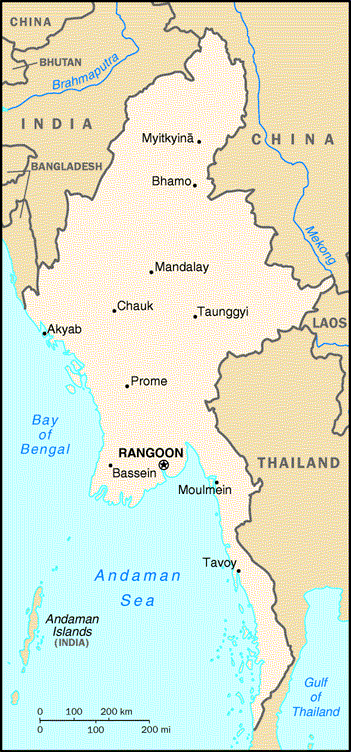Burma has been in an almost perpetual state of civil war since 1949. Human rights violations, brutal oppression against a mostly un-armed populace, child trafficking, and living conditions I would not subject a dog to (a central banker yes… a dog no) have been synonymous with Burma since its independence from Britain in 1948.
These guys have tried literally every form of socialist policy a fool could dream up, including the famed “Burmese way to socialism”, which saw the nationalization of every sector of the economy, excepting certain areas of agriculture.
The program was so spectacularly successful that it launched Burma rapidly and firmly into the ranks of one of the world’s most impoverished nations. Rice production collapsed by two thirds, and mineral exports fell 96%, and that’s just two sectors.
Tasked with solving this new found problem (Lord how on earth did this happen; they must have asked themselves…), the government did what any self-respecting, sociopathic, dimwitted, power hungry group of parasites would do. Instead of repealing the stunningly stupid program, they turned to “printing the wealth” and lo and behold enjoyed horrendous inflation. Who wouldathunkit? Heads up Ben and Mario! Nationalization of industries followed by monetary inflation… sounding eerily familiar? But I digress.
Today, Burma is one of the poorest countries in the world, with an estimated per capita GDP of just US$1400 (this is just an estimate based on purchasing power parity, as there are no reliable figures on this).
Actually, I strongly suggest you forget about statistics, since what figures you will find are typically so incorrect as to render them irrelevant or at best dangerously misleading. In any country dominated by an oppressive government, where economic activity is controlled by said government, you’ll find very little gets reported by the private sector correctly. What does get reported is taken and turned into spaghetti by the government statisticians, rendering it worthless anyway (Argentina anyone?).
One of the most accurate and easy to understand “indicators” I can think of would be to look at the disparity between the black market rate for the country’s currency and the quoted government rate. That one simple statistic, which you can discover in about half an hour on the ground, will tell you more than any of the governments statistical garbage ever will. The greater the disparity the more trouble the country is in.
In Burma the present black market rate is anywhere from about 850 – 1000 Kyat to 1 USD. The official government rate is about 7:1. Confidence is not yet high amongst locals, but I’ll be watching this closely since a place like Burma has the very real potential to make me filthy rich if the tide does indeed turn, and if I make some intelligent decisions.
If you have sufficient time in a country then I recommend some voyeurism in order to better ascertain the situation. In frontier markets it’s one the best possible due diligence techniques I can think of.
Worth remembering is that under British rule, Burma was the 2nd wealthiest country in Southeast Asia, and was the world’s largest exporter of rice. It was at this time also widely considered to be one of the most prospective countries in Asia. It did, and still has, large oil and gas reserves. In the agricultural space, rice, pulses and beans are major exports. Currently however, the market is still largely undeveloped and will offer some truly unbelievable prospects if and when the free market is finally allowed to work.
As you can see from the map, Burma is geographically and strategically located between India and China, two regional powerhouses with an appetite for both food as well as energy. Two things Burma can produce a lot of!
Burma’s vast natural gas reserves are clearly behind China’s decision to increase investment in Burma (considered a rogue nation by the US) in the way of port, pipeline and infrastructure deals.
China must see Burma as critically important to their energy independence, and strong relations with Burma would go some way to reducing China’s maritime transport vulnerability.
At the same time there is talk in Europe of lifting sanctions against the country. This in turn could well lead to a strategic battle by foreign players seeking economic access to Burma’s natural resources, and political leverage due to its geographic position in the region. How the present rulers, a civilian government made up of former military, manage this process will be very important for investors looking to get involved.
I was reminded of all of the above when talking recently with Douglas Clayton, CEO of Leopard Capital who believes that the changes afoot now are indeed solid. Douglas has been investing in emerging markets for over 25 years and has a deep knowledge and experience investing in frontier markets, and Asia in particular.
I’ll be taking a closer look early next year and will let you know what I find. I will also see if I can twist Douglas’ arm to bring you some of his thoughts on this, as well as other frontier markets worth exploring.
– Chris
“A speculator is a man who observes the future, and acts before it occurs” – Bernard Baruch




This Post Has 3 Comments
Jim Rogers thinks Myanmar (Burma) is the most undervalued trade in the world. Listen from 3 minutes 50 seconds onwards:
http://www.youtube.com/watch?feature=player_embedded&v=rVYOztEJlMc
Burma has a very good potential in the next coming decades. IMO, the time to invest hasn’t come yet (not just in Burma but anywhere in the world). Burma currently is having the biggest real estate bubble in its history.